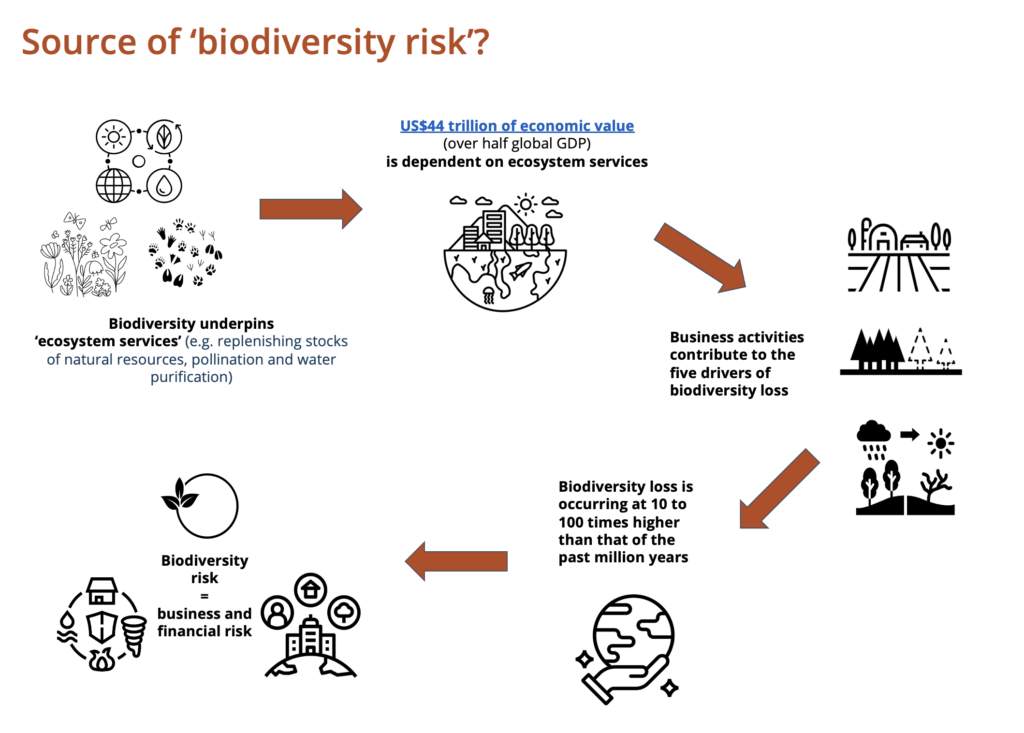By Jenni Ramos,
In mid-October the Commonwealth Climate Law Initiative (CCLI) delivered a workshop with the Legal Sustainability Alliance (LSA) on biodiversity risk for companies and organisations. This was the first part of a two-part series, the second, on the 15th November, will cover biodiversity risk in legal advice.
The workshop was a real eye-opener for me in demonstrating that the link between biodiversity loss and our work as lawyers is as real and deep as our impact on the climate crisis. Our opportunities to influence and bring about change through our work with clients is just as great. We’ve known for ages that the two are interlinked but the workshop helps to show that we can and must broaden our ambition away from a sole focus on carbon reduction and apply the same principles and approach that law firms are developing to the challenge of biodiversity loss.
David Berry, Partner & General Counsel, Charles Russell Speechlys LLP
Both workshops feature key messages from the CCLI’s December 2022 report ‘Biodiversity Risk: Legal Implications for Companies and their Directors’ (summarised in this short update).
Biodiversity (the variability among living organisms) is a characteristic of nature that underpins the resilience of ecosystems, which provide services to business and society, known as ‘ecosystem services’. Ecosystem services can be provisioning services (e.g. crops, wood or water), regulating and maintenance services (e.g. water flow regulation or pollination) or cultural services (e.g. recreation).

All of global GDP is somewhat dependent on nature, and for over half the economy this dependence is moderate to high. This dependence is often hidden in complex value chains spanning the globe. There is international consensus on the financial materiality of biodiversity risk, ranked by the World Economic Forum as the fourth most severe risk in the next 10 years and a facet of existing risk categories, manifesting as both physical and transition risks. Biodiversity-related business opportunities (e.g. value chain resilience, identifying new products/services, responding to changing consumer and employee preferences, increased investor/lender confidence or access to new capital) may not be discovered without considering how each business interacts with biodiversity.
An example of the biodiversity risk and life cycle of the construction trade:

Biodiversity risks and opportunities arise through a company’s impacts and dependencies on ecosystems. Directors’ duties to promote the success of the company and to exercise reasonable care and diligence may require oversight of material biodiversity related risks, including in the context of disclosure and financial reports. Last week, Australian national news and the FT’s Moral Money featured an independent legal opinion by Sebastian Hartford-Davis and Zoe Bush which concluded that nature-related risks to Australian companies should be regarded as foreseeable now. The opinion recommended that directors of Australian companies need to identify their company’s dependencies and impacts on nature and consider potential risks these pose to the company. Similar conclusions could be drawn in other common law jurisdictions such as the UK.
Participants at last month’s workshop explored what this means in practice for law firms and clients as organisations that have impacts and dependencies on biodiversity. We explored the value chain of the legal industry and a hypothetical client, analysing where each organisation might indirectly be dependent and impact upon biodiversity. We discovered that the legal sector is indirectly dependent on ecosystem services through its office buildings (through embedded impacts of its construction and ongoing use), the utilities, paper, furniture, textiles and information technology hardware used when delivering its services, food served to clients, work related travel (both the energy used to travel and vehicle components) and the operation of software and storage of electronic information. Through all these value chain connections the legal sector also impacts on biodiversity and plays a role in ecosystem degradation. This is even without the legal sector’s potential ‘advised nature impacts’ (similar to advised emissions – see the Legal Charter 1.5’s Principle 2, The Law Society’s climate change guidance and an Uncertain Solicitor guest post). A brief look at client sectors such as real estate, pharmaceuticals and construction discovered an even larger range of impacts and dependencies, including those arising from agricultural and mining raw materials.
Next steps for lawyers could include running their own workshop with colleagues and clients to explore organisational biodiversity impacts and dependencies or attending our 15th November workshop to look at biodiversity risk through a legal advice lens. Participants will engage in practical exercises identifying biodiversity liability risks in a fictional case study and managing biodiversity risk with contract clauses.
